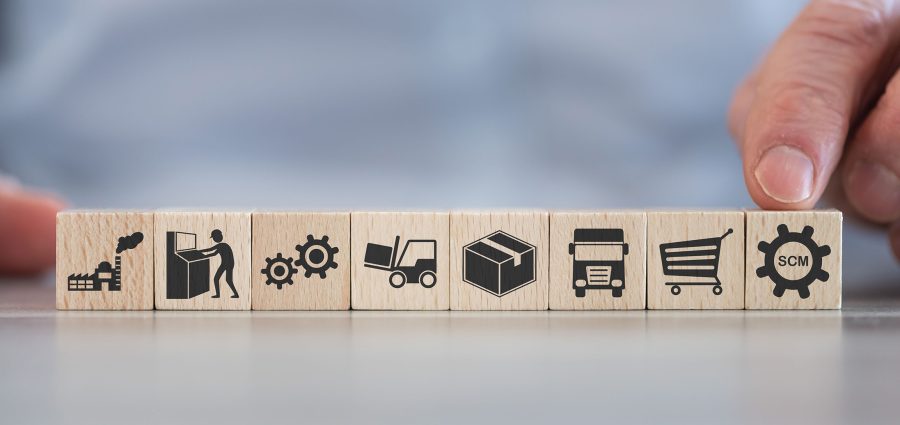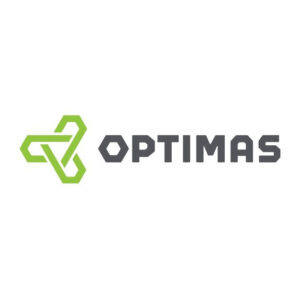You may not be able to avoid risk altogether, but you can mitigate it by choosing the right partners, strategies and resources. Being competitive in your industry means ensuring access to the parts you need while continuously improving productivity, shortening lead times, and saving money; the shorter and simpler your supply chain is, the better.
Recently, Adam Cherry, Vice President of Strategic Sourcing and Supply Chain at fasteners distributor and manufacturer Optimas Solutions, and Jeremy Clarke, VP of Supply Chain and Procurement at Optimas, sat down to discuss personally vetted supply chain management strategies for OEMs. Below is an edited transcription of their candid conversation to help you learn new insights and approaches to:
- Enhancing your bench strength
- Reacting to demand and production shifts
- Increasing visibility into your inventory
- Choosing manufacturing vs sourcing
- Automating day-to-day parts ordering, receiving, and stocking
- Integrating technologies into existing processes
- Impacting your company’s cash on hand’
Enhancing Your Bench Strength
How can one better enhance bench strength compared to other vetted providers during times of higher demand and when customary sources cannot deliver?

Adam Cherry, Optimas Solutions: The first step is planning ahead and ensuring that you know your strategy from a supply continuity and risk mitigation perspective and which parts and suppliers are critical from a production perspective. If you answer that all parts and suppliers are crucial, you need to get to the right level of detail to categorize or segment your portfolio. In the end, it comes down to effective communication with key suppliers. It is essential to understand their capabilities and where they may have gaps.
Jeremy Clarke, Optimas Solutions: Communication is critical. So, it is essential to ensure that your upstream suppliers understand your risks and that you communicate them truthfully. Proactively monitoring market conditions is vital, too. Understanding your customers’ market conditions — not just yours — and your vendor locations across the globe will help you manage the supply continuity risk.
Reacting to Demand and Production Shifts
Continuing on the theme of reacting to demand and production shifts, can a company obtain parts more reliably as required to match production levels?
Clarke: An accurate bill of materials is the first point to help drive the accuracy of supply and demand levels, with the understanding that products undergo many iterations of change through their life cycle. So, keeping on top of those changes and version indexes and ensuring you communicate those changes to your supply base as frequently as possible with the most detailed accuracy is essential. The more accurate you are, the better. Using all the tools available, including BOMs and all the updates to your vendor base that can support those forecasts, is critical to ensure you maximize the chance that demand and supply match and meet time requirements. Timely updates to vendor base reporting and demand fluctuations keep vendors abreast of those changes, which helps them better plan their capacity.
Cherry: Agreed, laying a foundation around the expectations when production volumes change with vendors is essential. As yourself, how well do you communicate with your vendor partners, and what are the expectations when that communication comes through? Also, it’s good to understand the indirect impact on demand or usage when production changes are needed. Companies are already spending time on where vendors need to catch up. It would help if you continued to focus on the most impactful areas, even when times are smooth. So proactively building those relationships with your strategic vendors is good, so when something does happen, which it undoubtedly will, you’re ready and prepared for that.
Increasing Visibility into Your Inventory
How can I better increase visibility into the inventory available to me from my current service provider?

Clarke: The first question is, what do you want to see from your service provider? Whether it is risk or costs, work with the providers to get to that level of understanding. Usually, we want to see it around risk — the kind of understanding and visibility around where you will get problems or problem items that run smoothly. Getting it right and getting the risk visibility right is difficult at times, and working through and communicating freely with your service provider helps it be an efficient process. Although information systems are essential today, I think reliance on having those direct communications up front is a good practice in conjunction with accessing portals and other digital communications.
Cherry: The partnership is undoubtedly essential. You can integrate more through available technical tools like EDI and sharing inventory levels, but the key is understanding their overall planning process. Proactively deciding upon a regular cadence to review those levels to ensure compliance is a crucial step. The other thing to think about is the visibility of inventory. You are learning from a current proxy that isn’t in your current bomb or something that you resolved from another vendor issue. You can also learn something else from a potential new project. That’s why having access to your service provider’s information and details on inventory that’s available can help dramatically. There’s a mix of those tools that can give a good, rounded view of what’s available to you.
Manufacturing Vs. Sourcing
When is it best to manufacture rather than source a fastener? And how can I tell if my current suppliers can introduce custom or HOT parts manufacturing?
Cherry: A couple of varied factors come to the forefront for me. Supply continuity is undoubtedly a big part of it. So, understanding your supply base’s ability and potential risk to the operation is an advantage in having control and visibility by manufacturing a part yourself. Assuming that you have the capacity and flexibility to account for variation within the supply chain, you also have to ask about your ability to source more competitively than your current or prospective supply base. So, understanding the same components on raw material vendors if you plan to manufacture is also a critical aspect.
Clarke: I could not agree more, Adam. A key point to remember is to ensure your manufacturing partner can also increase the ability to protect margin for your customers.
Automating Day-to-Day Parts Ordering, Receiving and Stocking
Moving on to process automation, how can one automate day-to-day parts ordering, receiving and stocking?
Clarke: Make sure you have the selected service partner you know works in true partnership with you so they understand your business, goals and objectives. Then, you must also ensure your BOM alignment synergizes with the demand output that’s going through. The starting point of automation is accuracy through BOM and demand alignment. Use your history with your supplier or manufacturing partner to understand the nuances and build up from very manual to automated processes. Communication in that process is crucial. But you’re making sure they’re in lockstep with the activities that you’re doing. It’s reducing transactional activity where you can and automating those process flows as much as possible. So, as you’ve got that movement and improved information flow, you get your product at the dock.
Cherry: When you talk about the more technical aspects and that information sharing between you and your vendor base, you have to make sure there’s an excellent understanding of the end-to-end both for you and the partners you’re sharing information with and expecting information from. So make sure there’s that upstream understanding of what information is needed when automating this type of data flow. Formatting and different technical things must be considered and well understood on both ends. When you talk internally about automation, it’s making sure your operating systems are compatible. When you think about your ERP, MRP and WMS systems, are you using one platform that tends to allow for more seamless data sharing and automation integration, or are you using different platforms? If you use different platforms, seamless day-to-day data communication is the key between those systems.
Integrating Technology into Existing Projects
Continuing on the theme of process automation, what technology can I incorporate into my operation that automates manual tasks and provides data for future planning?
Cherry: When thinking about automation specifically from a process perspective, there are a lot of emerging technologies and various established technologies out there. You hear a lot about AI today, as many companies are trying to become more comfortable with it. Machine learning is a great tool that’s used a great deal in inventory management and demand modeling solutions. It could also be about ensuring you get the most out of your current systems. So, when you think about your MRP systems, do you have the confidence in your data and systems to allow for more system automation when it comes to repetitive tasks such as purchase order placements, acknowledgments, past-due management activities, and such?
Clarke: It’s about automating repetitive tasks. Purchase order placements are excellent as they are repetitive tasks that AI can potentially deliver savings and efficiency. I think the other thing to remember is that as you go through any implementation of AI, watch any knowledge depletion it could create. What tribal knowledge erodes from your organization, and how do you capture that? A machine can’t know every scenario. So, as you remove some of that institutional knowledge that you may have and experience you’ve captured over time, you need to figure out how to nuance that expertise into the process. So, how do you capture it? How do you ensure that you stay on top of that and keep that in check with your AI as well? There is a risk there with that, so that you know, but equally, an opportunity to ensure it’s captured.
Impacting Your Company’s Cash On-Hand
Sourcing partners impact my company’s cash on-hand and manufacturing efficiency. How can I source it?
Clark: Certainly, with your sourcing partners, you know having the right partners for your operation is vital, and having an understandable agreement with specifics to cash flow is essential. Maintaining that output through efficiency is critical, some of which comes from your agreement. Ensure that those negotiated agreements embrace robust longevity where it works for both parties. But also, there’s no cost of inferior quality hitting you through any of the processes your sourcing partner completes. So yes, having those robust agreements may also be vital in helping you control that cash.
Cherry: It’s excellent to also think about what’s outside the contract, the pricing terms, and things like that. You know, bringing it back to supply continuity and how important that can be from an operation perspective is about keeping the operation running to avoid unnecessary expense. So you certainly want to focus on communication and the partnership and ensure you’re fostering those vendor relationships, but the ultimate goal is to avoid waste. And there are indirect and direct forms of that waste. Indirect could be the cost of resourcing or finding a new vendor. Indirect is inherent efficiencies. This is to ensure supply continuity and then have ways to expedite material while the process is running as a last resort.
Advice from the Experts
And what is one of the critical things that you keep in mind, or are lessons you’ve learned that you’d like to share with other supply chain executives?
Clarke: The biggest tip I would give is never to assume. Just because you have an iron-clad contract in place does not mean you can safely assume that an urgent shipment will make it onto an aircraft or even arrive at an airport every single time. Find a vendor willing to be transparent with every step within the supply chain activity to achieve that high-level piece of mind. Then, you can walk away knowing that it’s going to happen. More important is to have a plan in place for emergencies with your vendor, whether on a longer-term strategic plan or a reactive, short-term expediting activity. I don’t assume that something’s going to take place. So, put in the work and due diligence to ensure it sticks and you know it flows through. That is the advice I’d give anybody.
Cherry: Yes, trust, but verify. I recommend that as well. For me, what kind of jumps out throughout my career is just making sure that you’re balancing the day-to-day sort of short-term actions that you’re trying to use to drive value within your supply chain with your business in the long term. Then, make sure you’re making robust decisions that lead to long-term stability and health for the company and the supply chain overall. You have to focus on both, and it can be difficult for people to take a step back and try to keep that balance. Overall, you know supply chains for a company shouldn’t be cost centers. They should be competitive advantages, so for that to occur, you have to balance the long term with the short term in terms of the needs of the supply chain role within a company.
The Role of a Supply Chain Partner
How does your role impact the service that Optimas provides?
Clarke: Obviously, the title “supply chain and procurement” gives a little insight into what I do at Optimas. But it goes a lot deeper than that and is best described as strategic end-to-end supply chain management. Optimas provides true end-to-end support, from the inception of a part design for a customer to ensuring that the component arrives at their finished dock for finished goods, which would be the better way of describing it. It is always about the customer. There is nothing more important.
Cherry: So I have the pleasure of serving as the Vice President of Strategic Sourcing and Supply Chain for the Americas region here at Optimas, and similar to Jeremy, for me, it’s just about ensuring my manufacturing customers can keep their operations running at the speed and pace that they want to, making it as profitable for them as it can be and just keeping some of the day-to-day worries that many companies have to face in terms of inventory and availability of parts entirely off the radar.
Optimas takes challenges and is proactive in our communication, ensuring we’re working as a full-service partner to provide business solutions that increase efficiency and profitability for the end customer.
The Final Word
Any final thoughts on this topic?
Cherry: When you think about it, you know you’ll have things that come up. You’re going to have changes in demand and forecasts. You’re going to have supply chain issues, either regionally or globally. It comes down to how you plan and anticipate those challenges and ensure that you and your critical vendors are aligned on what path you take when those situations occur, all for the benefit of the end customer.
Clarke: The common themes are effective communication and understanding your supply base. I’m a big believer in working through communication flows. Certainly, everything else we discussed here is essential, but how good communications impact every part of the supply chain is tremendously important. We need to make sure we are doing the best job communicating as we can — both ways — and, of course, with the end customer.
Related Posts
-
Terry Rosser takes the company's new CSO role after serving in supply chain roles at…
-
Ferguson locations nationwide have joined Trimble's digital pricing and procurement network to further digitize the…
-
Electrical distributor Viking Electric created two roles as part of an organizational structure change to…






